Inch Plant Care: Tradescantia Zebrina (Wandering Jew Plant) Propagation Indoors
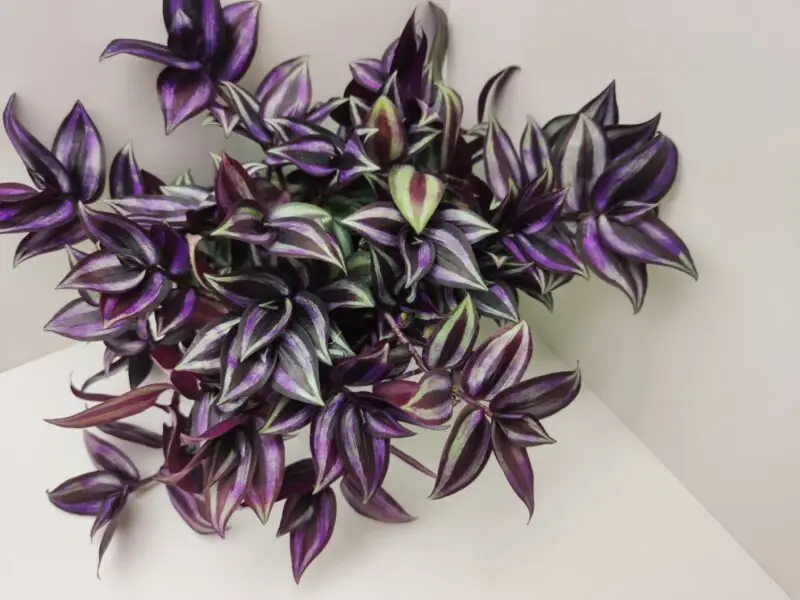
Introduction to Wandering Jew Plant
Stepping into the enchanting realm of houseplants, we meet an effervescent charmer known as the inch plant. Also known as Tradescantia zebrina, this plant brings an alluring touch of purple and green foliage into your indoor spaces. It is as captivating as it is easy to grow, proving itself as a must-have addition to your indoor plant collection.
Botanical Information
Underneath its popular moniker, the inch plant is botanically referred to as Tradescantia zebrina. This particular species is part of the larger Tradescantia genus, which belongs to the Spiderwort family. The plant is perennial, meaning that with proper care, you’ll witness its splendid trail indoors for many years.
Common Names and Varieties
It’s not just the botanical world that recognises this fascinating indoor plant. In the realms of common language, it is also widely known as ‘Wandering Jew’ or ‘Wandering Dude’. This common name inch plant, however, paints a vivid image of its growth habits and trailing plant nature. While the species most popular as a houseplant is Tradescantia zebrina with its distinctive stripes, there are several other varieties of inch plants that also make splendid indoor plant options.
Tradescantia Zebrina Plant Characteristics
Appearance and Growth Habits
The inch plant’s allure lies in its foliage. Its leaves, displaying striking bands of purple and green, create a visual feast for any plant lover. These leaves trail elegantly from the pot, creating an impressive cascading effect. The plant grows at an easy pace of roughly an inch a week, thus its common name, while it can trail up to several feet.
Propagation
Propagation, in the case of inch plants, is as easy as a summer’s day. The plant is ready to propagate usually in the spring or summer – the growing season when the plant is in its prime. A simple cutting from the plant, when placed in contact with the soil, can lead to new growth. This makes growing inch plants from cuttings an effortless delight, bringing new plants into the world with minimal fuss.
Ideal Conditions to Grow Inch Plants
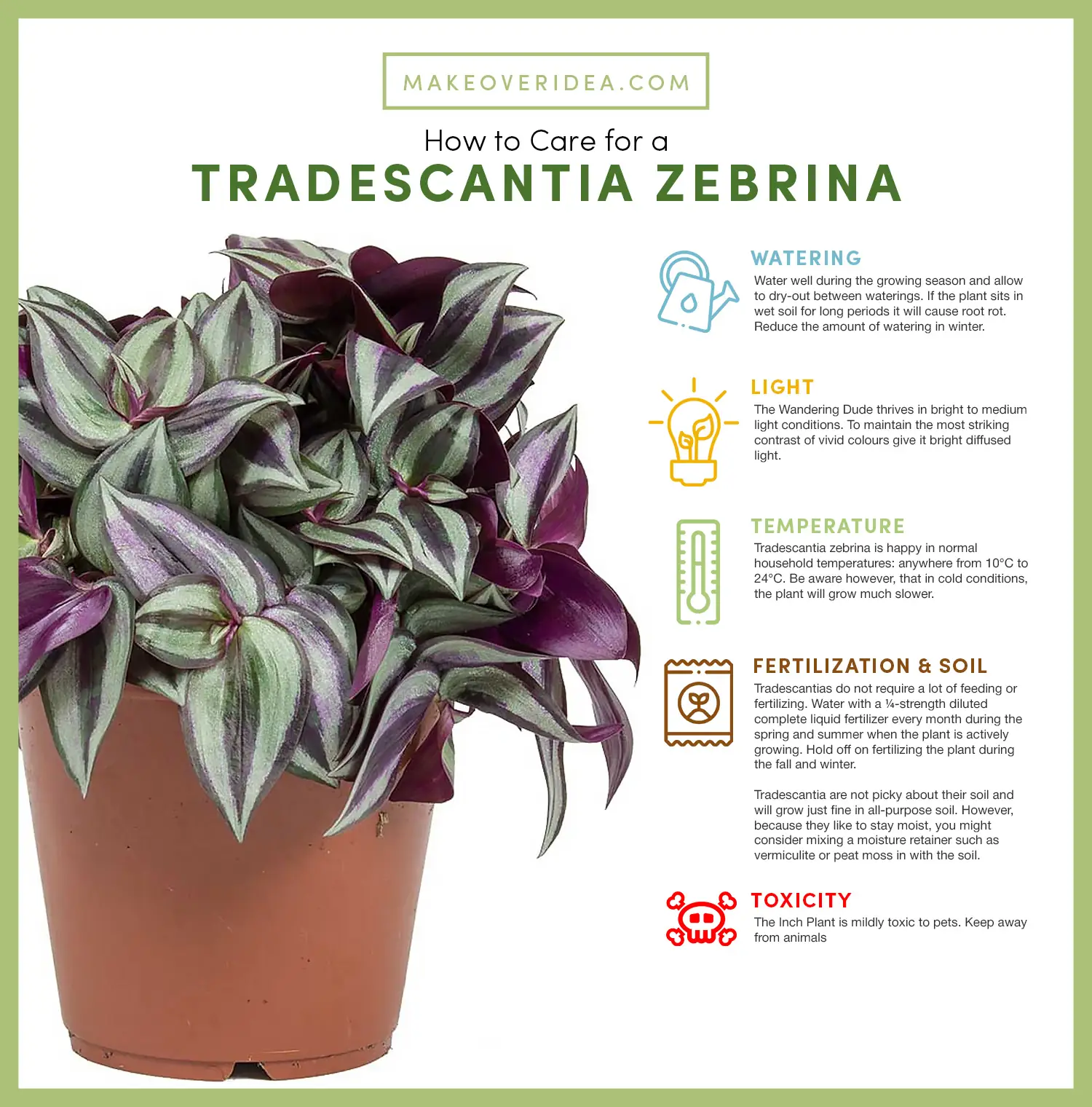
Soil and Potting
While an easy care houseplant, there are certain conditions that the inch plant favours. When it comes to soil and potting, it likes its roots cozy in fresh potting soil that’s well-draining. This helps to prevent root rot and keeps the soil from becoming too soggy. The rule of thumb is to keep the soil moist but not waterlogged. Care should be taken not to let the top few inches of soil dry out completely. To give your plant a happy home, choose a pot with adequate drainage and change the potting mix annually to replenish nutrients.
Light Requirements
Light plays an essential role in the life of wandering dude. The plant thrives in bright, indirect light, often showing its appreciation through vibrant leaf coloration. If the plant isn’t getting enough light, it might tell you by becoming less colourful and vibrant. A plant that’s moved to a brighter location or even under a grow light will often bounce back with zeal.
Temperature Requirements
Inch plants love to bask in the warmth, so maintaining a steady indoor temperature is key to their happiness. Ideal conditions are usually between 65°F to 75°F (18°C to 24°C). Additionally, these plants love a good dose of humidity. Regular misting of the plant can provide that extra bit of moisture it loves.
Inch Plant Care Guide and Maintenance
Watering Instructions
Water is the lifeblood of any plant, and inch plants are no different. In fact, they appreciate a good drink. The key, however, is to ensure that the water intake is just right. Too much water can lead to soggy soil and potential root rot, while too little can dry out the plant. The best rule of thumb is to water your inch plant when the top inch of soil feels dry to the touch.
Fertilization Schedule
Inch plants thrive when fed with a balanced liquid fertilizer. During the growing season, which typically spans spring and summer, a monthly feeding schedule can do wonders for your inch plant’s health and growth. During the colder months, you can reduce this to once every six weeks as the plant enters a resting period.
Pruning and Repotting
Pruning your inch plant is essential to keep the plant looking its best and to encourage new growth. Prune the plant in the spring and summer months, focusing on any leggy or sparse areas. If you’ve got a growing inch plant that seems to be outgrowing its pot, it may be time for repotting. Replace the pot with a larger one and introduce fresh potting soil to give your plant a renewed lease on life.
How to Propagate Wandering Jew
Propagation from Cuttings
Propagation from cuttings is a simple and effective way to multiply your inch plants. All it requires is a healthy cutting, some fresh potting mix, and a pot. Place the cutting into the soil, ensuring that a node is in contact with the soil, and wait for new growth to emerge. Soon enough, you’ll have a new inch plant to add to your collection.
Propagation Tips
To maximize your chances of successful propagation, ensure that your cutting has a few healthy leaves, and the node is undamaged. Keep the soil moist and warm to encourage rooting. Inch plants can easily be propagated throughout the growing season, but spring or summer is generally the ideal time.
Common Problems and Solutions
Insect Pests
Inch plants, like many indoor plants, can sometimes attract unwanted guests. Common pests include aphids and spider mites. If you notice small bugs or a sticky residue on your plant, it might be time to intervene. A gentle shower can remove many pests, or you can introduce a natural insecticide to deal with more persistent critters.
Disease Issues
Watering issues often lead to the most common diseases for inch plants, including root rot and leaf spot. Root rot often manifests as yellowing leaves and a generally unhealthy looking plant. The best solution is to address the watering problem and repot the plant with fresh, well-draining soil. Leaf spot can be treated with fungicides and by removing the affected leaves.
Other Potential Problems
Insufficient light can cause your inch plant to lose its vibrant colouration. If your plant isn’t getting enough light, consider moving the plant to a brighter location or introducing a grow light.
On the whole, an inch plant is a resilient creature. Providing the right balance of light, water, and care, you can overcome any obstacle that comes your way. Enjoy the lush growth of this stunning trailing plant and the unique beauty it brings to your indoor plant family.
Variety Highlights
Tradescantia zebrina ‘Tricolor’
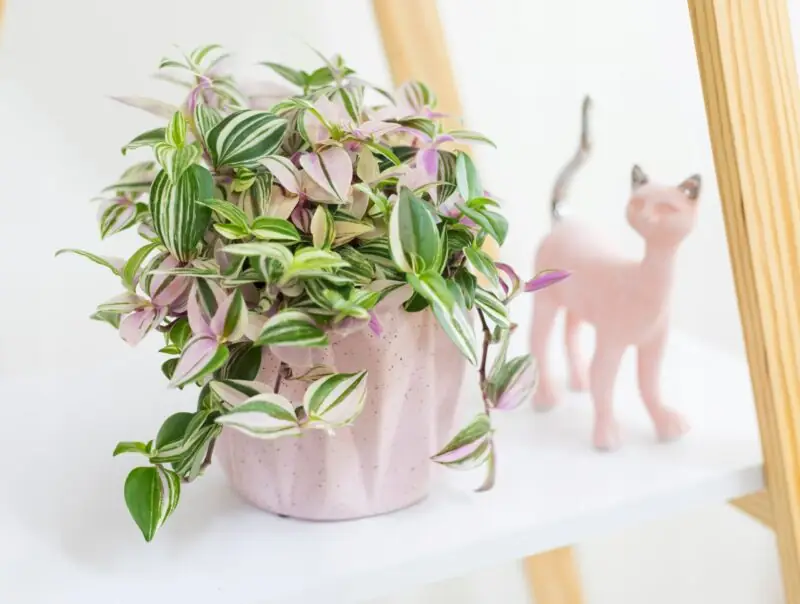
First on our roster is the Tradescantia zebrina ‘Tricolor’. This delightful variety is marked by its distinctive three-toned leaves, showcasing shades of green, red, and cream. It offers the same trailing charm as other inch plants but with an added dash of colour, making it a vibrant addition to any indoor space.
Tradescantia pallida ‘Purple Heart’
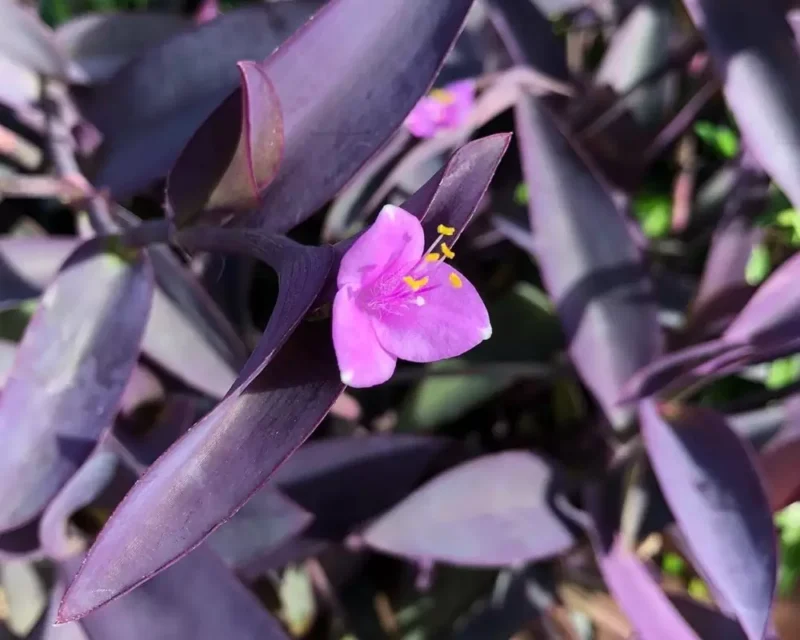
The Tradescantia pallida ‘Purple Heart’ is a heart-stealer with its deep purple foliage. This inch plant variety is known for its strong purple color that can add a rich, dramatic touch to your indoor plant collection. It’s also highly adaptive, making it a fuss-free choice for both beginners and seasoned plant parents.
Tradescantia fluminensis ‘Quicksilver’
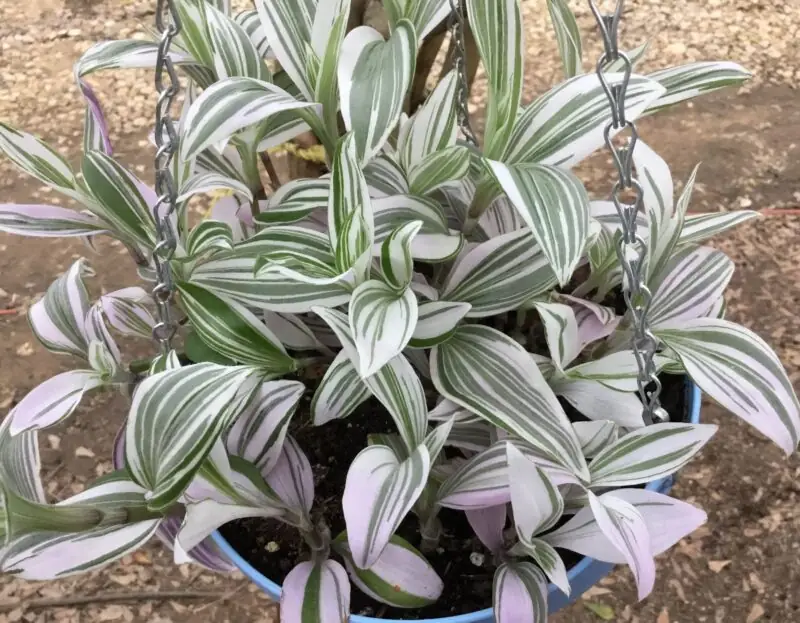
The Tradescantia fluminensis ‘Quicksilver’ is known for its silvery leaf color and compact growth habit. It’s a smaller and more modest inch plant, perfect for those with limited space or who prefer a more subtle aesthetic. Despite its smaller size, this variety still offers the easy care and resilience that inch plants are loved for.
FAQs
The rule of thumb is to water your inch plant when the top inch of the soil feels dry to the touch. Overwatering can lead to soggy soil and potential root rot, so be sure not to let the plant sit in water.
Inch plants prefer bright, indirect light. If the plant isn’t getting enough light, it may lose its vibrant color. Consider moving the plant to a brighter location or introducing a grow light if necessary.
Propagation from cuttings is straightforward. Just take a healthy cutting from the plant, ensuring a node is in contact with fresh potting mix in a pot, and wait for new growth to emerge.
Inch plants can sometimes face issues such as insect pests, diseases like root rot and leaf spot, or problems due to insufficient light. Regular inspection, correct watering, and providing adequate light can help prevent these problems. If pests or diseases do appear, use natural insecticides or fungicides, and consider repotting if necessary.
Yes, inch plants can also be grown outdoors. However, they are more commonly grown as indoor plants due to their love for warm, humid conditions, which are easier to maintain indoors.
Conclusion
As we meander through the world of inch plants, it’s evident that these houseplants are a treat for both the novice and the experienced plant lover. Whether it’s the classic Tradescantia zebrina, the vibrant ‘Tricolor’, the dramatic ‘Purple Heart’, or the modest ‘Quicksilver’, there’s an inch plant to suit every taste and preference.
These plants love a bright spot in your home, a drink when their soil dries out, and a dose of fertilizer during their growing season. They offer a splendid trailing spectacle and prove to be an easy to care for and propagate companion.
In conclusion, the inch plant, with its striking foliage and easy-going nature, is ready to take root in your home and heart. As you offer it a warm place in your home, it’s bound to reward you with its vibrant growth. As we often say in the world of plants – the more, the merrier. Grow inch plants in your home, and watch your indoor plant family flourish.